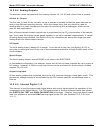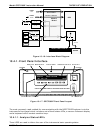
Model GFC7000E Instruction Manual THEORY OF OPERATION
04584 Rev A1 180
During instrument calibration (see Chapter 7) the user enters expected values for zero and span
via the front panel keypad and commands the instrument to make readings of calibrated sample
gases for both levels. The readings taken are adjusted, linearized, and compared to the expected
values, With this information the software computes values for instrument slope and offset and
stores these values in memory for use in calculating the CO
2
concentration of the sample gas.
The instrument slope and offset values recorded during the last calibration can be viewed by
pressing the following keystroke sequence:
SAMPLE RANGE = 50.0 MGM CO =XX.XX
< TST
TST > CAL SETUP
SAMPLE
TIME = 16:23:34
CO =XX.XX
< TST
TST > CAL SETUP
SAMPLE
OFFSET = 0.000
CO =XX.XX
< TST
TST > CAL SETUP
SAMPLE
SLOPE = 1.000
CO =XX.XX
< TST
TST > CAL SETUP
10.5.3. Measurement Algorithm
Once the IR photo-detector is signal is demodulated into CO2 MEAS and CO2 REF by the
sync/demod board and converted to digital data by the mother board the MGFC7000E analytical
software calculates the ratio between CO2 MEAS and CO2 REF. this value is compared to a look-
up table is used, with interpolation, to linearize the response of the instrument. The linearized
concentration value is combined with calibration slope and offset values, then normalized for
changes in sample gas pressure to produce the final CO
2
concentration. This is the value that is
displayed on the instrument front panel display and is stored in memory by the analyzer’s iDAS
system.
10.5.4. Temperature and Pressure Compensation
Changes in pressure can have a noticeable, effect on the CO
2
concentration calculation. To
account for this, the Model GFC7000E software includes a feature which allows the instrument to
compensation of the CO
2
calculations based on changes in ambient pressure.
The TPC feature multiplies the analyzer’s CO
2
concentration by a factor which is based on the
difference between the ambient pressure of the sample gas normalized to standard atmospheric
pressure. As ambient pressure increases, the compensated CO
2
concentration is increased.
10.5.5. Internal Data Acquisition System (iDAS)
The iDAS is designed to implement predictive diagnostics that stores trending data for users to
anticipate when an instrument will require service. Large amounts of data can be stored in non-
volatile memory and retrieved in plain text format for further processing with common data
analysis programs. The iDAS has a consistent user interface in all Teledyne Instruments
analyzers. New data parameters and triggering events can be added to the instrument as needed.


















